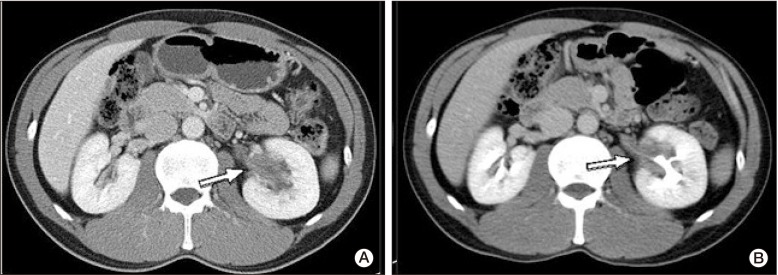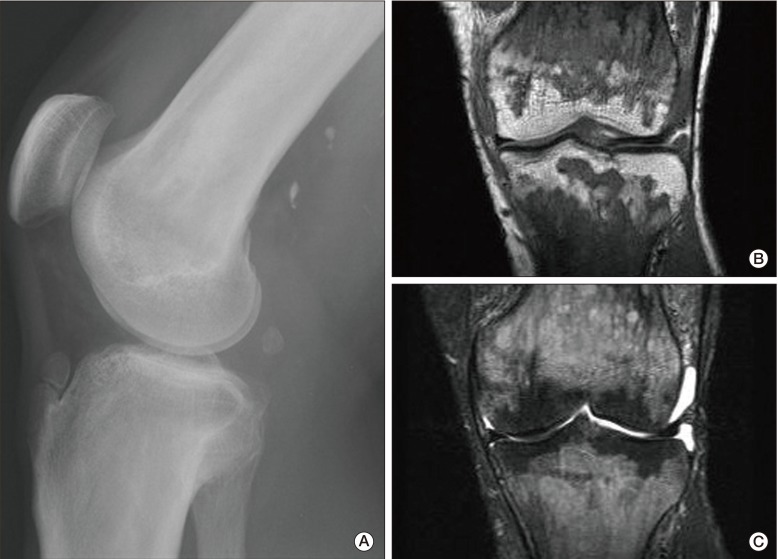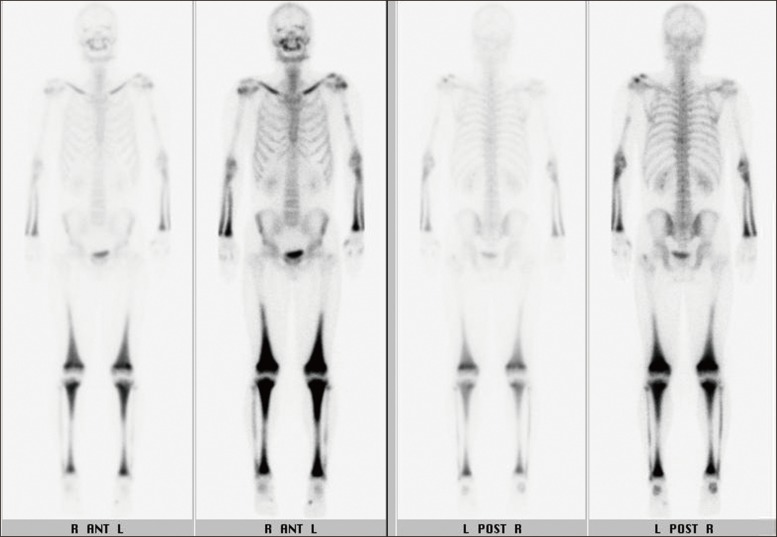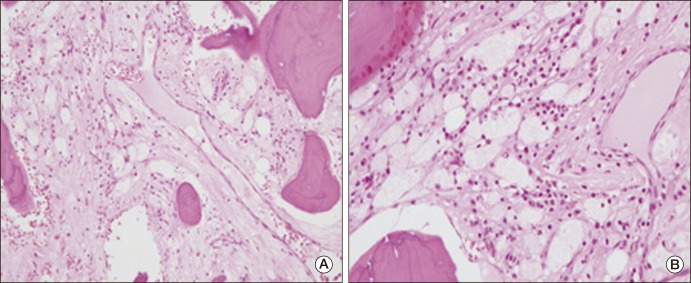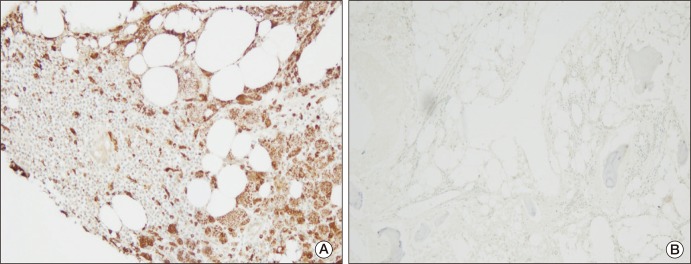Cancer Res Treat.
2012 Jun;44(2):146-150.
A Case of Erdheim-Chester Disease with Asymptomatic Renal Involvement
- Affiliations
-
- 1Department of Internal Medicine, Seoul National University Hospital, Seoul National University College of Medicine, Seoul, Korea. gabriel9@snu.ac.kr
- 2Department of Pathology, Seoul National University Hospital, Seoul National University College of Medicine, Seoul, Korea.
- 3Department of Orthopedic Surgery, Seoul National University Hospital, Seoul National University College of Medicine, Seoul, Korea.
Abstract
- Erdheim-Chester disease is a rare non-Langerhans-cell histiocytosis involving bones and multiple organs. Its clinical course can vary, from an asymptomatic state to a fatal disease, with renal involvement being a common cause of death. A 41-year-old man presented with a 10-month history of bilateral lower limb pain. Left perirenal soft-tissue infiltration had been found incidentally two years earlier. No progression of the lesion or deterioration of renal function was observed for a period of two years. At admission, plain radiography and magnetic resonance imaging of the patient's lower limbs showed patchy osteosclerosis. Biopsy of the tibia revealed histiocytic infiltration, which was found to be positive for CD68 and negative for CD1a. This report describes an unusual case of Erdheim-Chester disease involving a stationary course of disease with no specific treatment for a long period of time.
MeSH Terms
Figure
Reference
-
1. Chester W. Über lipoidgranulomatose. Virchows Arch Pathol Anat Physiol. 1930; 279:561–602.
Article2. Park YK, Ryu KN, Huh B, Kim JD. Erdheim-Chester disease: a case report. J Korean Med Sci. 1999; 14:323–326. PMID: 10402177.
Article3. Veyssier-Belot C, Cacoub P, Caparros-Lefebvre D, Wechsler J, Brun B, Remy M, et al. Erdheim-Chester disease. Clinical and radiologic characteristics of 59 cases. Medicine (Baltimore). 1996; 75:157–169. PMID: 8965684.
Article4. Zelger B, Cerio R, Orchard G, Wilson-Jones E. Juvenile and adult xanthogranuloma. A histological and immunohistochemical comparison. Am J Surg Pathol. 1994; 18:126–135. PMID: 8291651.5. Case records of the Massachusetts General Hospital. Weekly clinicopathological exercises. Case 9-2000 A 41-year-old man with multiple bony lesions and adjacent soft-tissue masses. N Engl J Med. 2000; 342:875–883. PMID: 10727593.6. Weitzman S, Jaffe R. Uncommon histiocytic disorders: the non-Langerhans cell histiocytoses. Pediatr Blood Cancer. 2005; 45:256–264. PMID: 15547923.
Article7. Mossetti G, Rendina D, Numis FG, Somma P, Postiglione L, Nunziata V. Biochemical markers of bone turnover, serum levels of interleukin-6/interleukin-6 soluble receptor and bisphosphonate treatment in Erdheim-Chester disease. Clin Exp Rheumatol. 2003; 21:232–236. PMID: 12747282.8. Boissel N, Wechsler B, Leblond V. Treatment of refractory Erdheim-Chester disease with double autologous hematopoietic stem-cell transplantation. Ann Intern Med. 2001; 135:844–845. PMID: 11694122.
Article9. Haroche J, Amoura Z, Trad SG, Wechsler B, Cluzel P, Grenier PA, et al. Variability in the efficacy of interferon-alpha in Erdheim-Chester disease by patient and site of involvement: results in eight patients. Arthritis Rheum. 2006; 54:3330–3336. PMID: 17009306.10. Braiteh F, Boxrud C, Esmaeli B, Kurzrock R. Successful treatment of Erdheim-Chester disease, a non-Langerhans-cell histiocytosis, with interferon-alpha. Blood. 2005; 106:2992–2994. PMID: 16020507.11. Suzuki HI, Hosoya N, Miyagawa K, Ota S, Nakashima H, Makita N, et al. Erdheim-Chester disease: multisystem involvement and management with interferon-alpha. Leuk Res. 2010; 34:e21–e24. PMID: 19679354.12. Sanchez JE, Mora C, Macia M, Navarro JF. Erdheim-Chester disease as cause of end-stage renal failure: a case report and review of the literature. Int Urol Nephrol. 2010; 42:1107–1112. PMID: 20232144.
Article
- Full Text Links
- Actions
-
Cited
- CITED
-
- Close
- Share
- Similar articles
-
- Commentary on "A Case of Erdheim-Chester Disease with Asymptomatic Renal Involvement"
- Reply to Commentary on "A Case of Erdheim-Chester Disease with Asymptomatic Renal Involvement"
- Erdheim-Chester Disease with Perirenal Masses Containing Macroscopic Fat Tissue
- Erdheim–Chester Disease Involving the Biliary System and Mimicking Immunoglobulin G4-Related Disease: A Case Report
- A Case of Erdheim-Chester Disease with Bilateral Hydronephrosis

